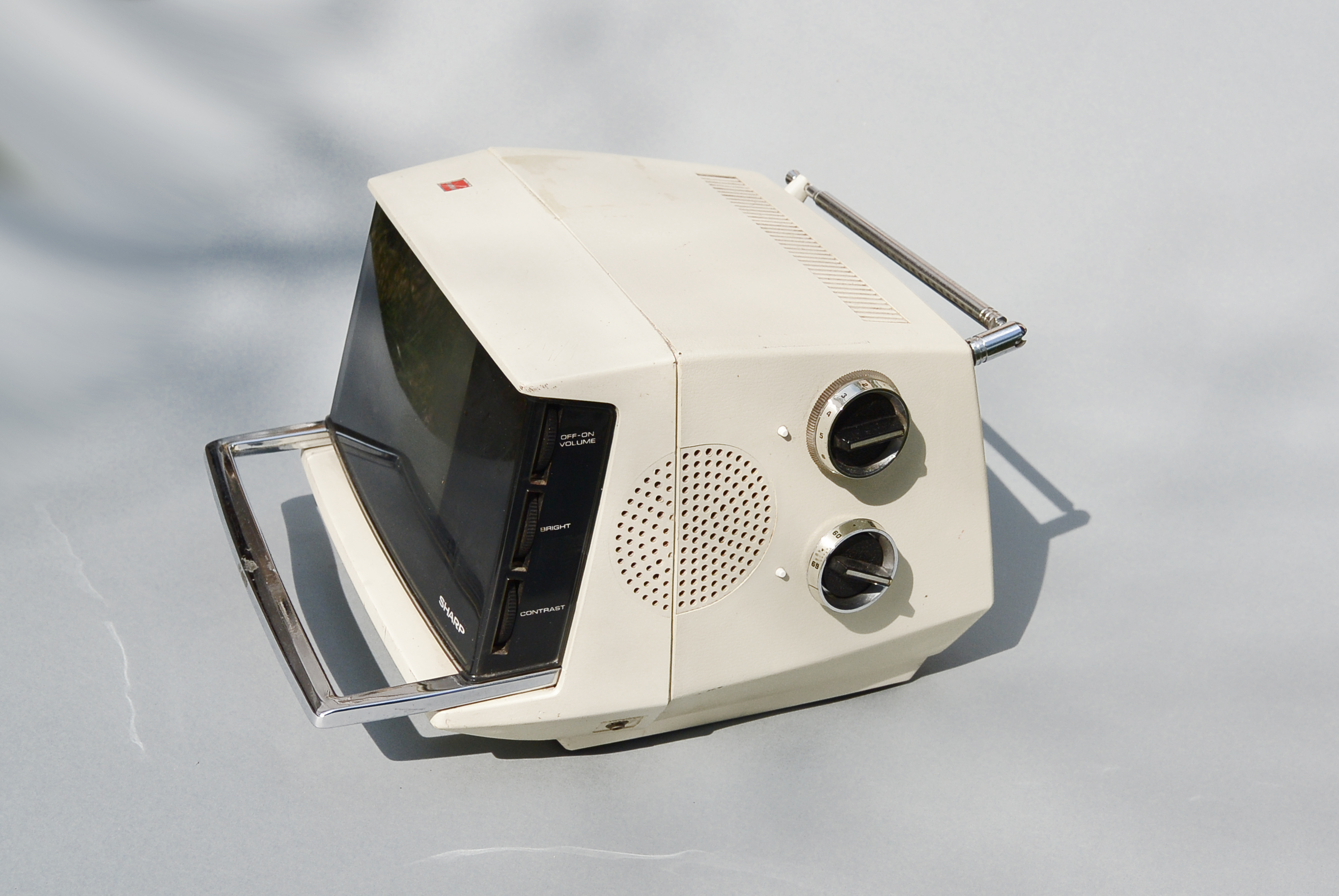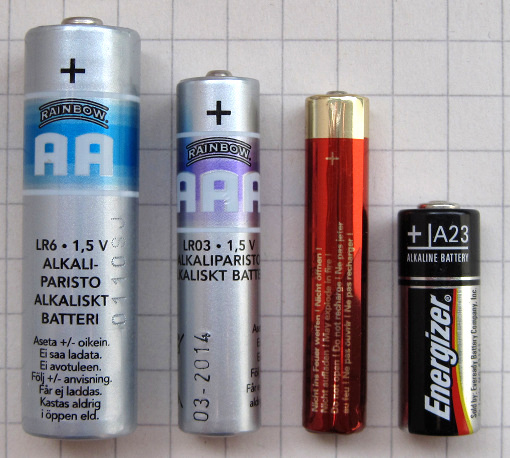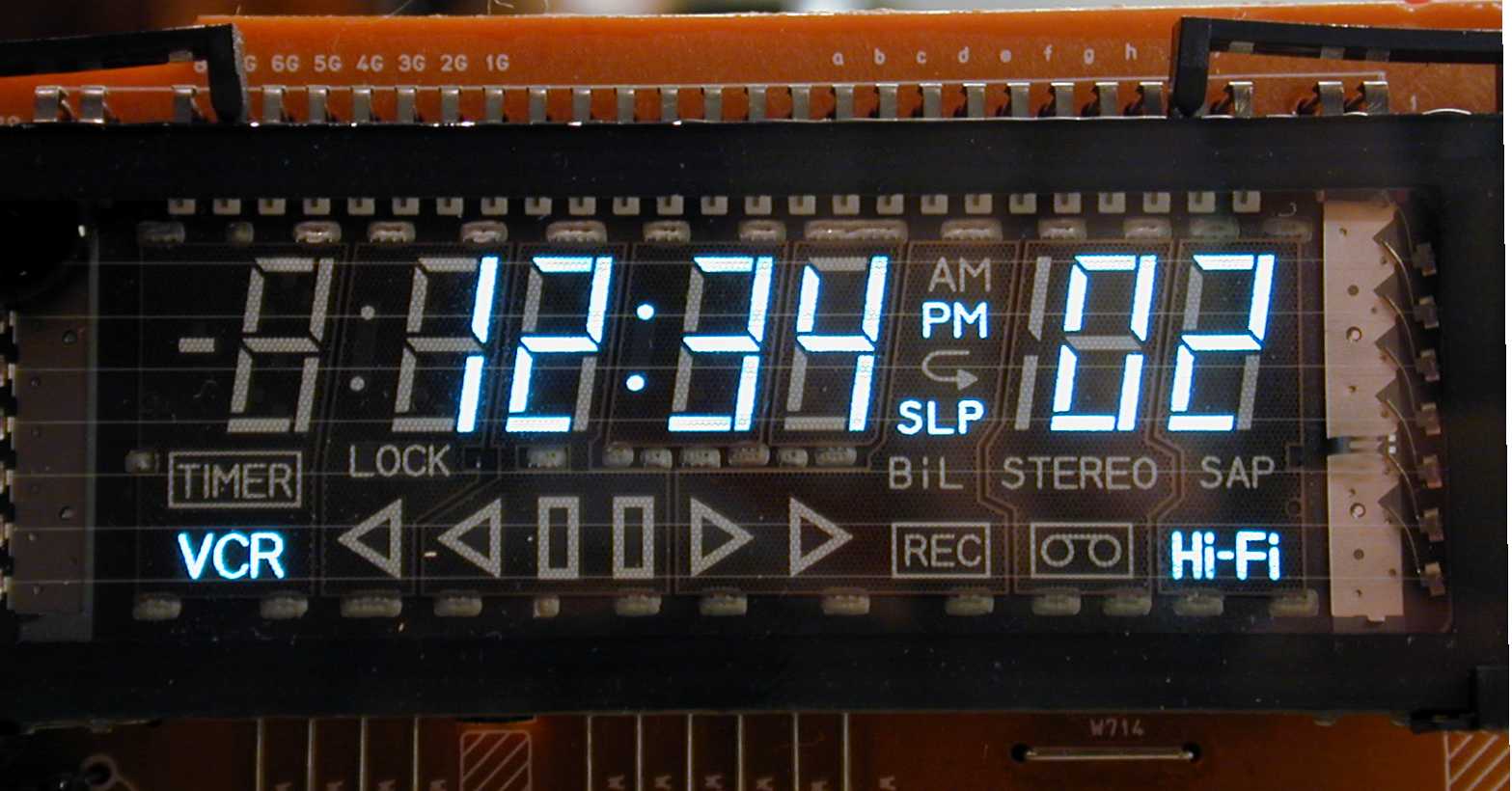|
Sharp QT-8B
The Sharp QT-8B Micro Compet, a portable electronic desktop calculator, was the first mass-produced calculator to be battery-powered. Introduced in mid-1970, it was based on its immediate predecessor, the QT-8D introduced in late 1969, but it replaced the QT-8D's integrated power supply with a rechargeable battery pack. It has the same calculating integrated circuits as the QT-8D and is of similar appearance and dimensions; the power supply is the only major difference. The QT-8B's release price in Japan was 117,000 yen. The U.S. price in mid-1971 was $495, equivalent to about $2,700 in 2010. These prices were somewhat higher than those for the preceding QT-8D. The QT-8B's battery pack contains six nickel-cadmium C batteries connected in series, giving a total voltage of 7.5 volts and, with the original batteries, a total capacity of 1200 milliampere-hours. (Modern nickel-cadmium C batteries have much greater capacity.) For recharging, the calculator accepts 12-volt DC extern ... [...More Info...] [...Related Items...] OR: [Wikipedia] [Google] [Baidu] |
Sharp Corporation
is a Japanese multinational corporation that designs and manufactures electronic products, headquartered in Sakai-ku, Sakai, Osaka Prefecture. Since 2016 it has been majority owned by the Taiwan-based Foxconn Group. Sharp employs more than 50,000 people worldwide. The company was founded in September 1912 in Tokyo and takes its name from one of its founder's first Ever-Sharp mechanical pencil, which was invented by Tokuji Hayakawa in 1915. History Early years 1912–1945 In 1912, Tokuji Hayakawa founded a metal workshop in Tokyo. The first of his many inventions was a snap buckle named 'Tokubijo'. Another of his inventions was the Ever-Ready Sharp mechanical pencil in 1915. The product became one of the first internationally available mechanical pencils (while concurrent US design replaced it soon and became a modern type), and due to this big success the Sharp Corporation derived its name from it. After the pencil business was destroyed by the 1923 Great Kantō earthqu ... [...More Info...] [...Related Items...] OR: [Wikipedia] [Google] [Baidu] |
Voltage
Voltage, also known as electric pressure, electric tension, or (electric) potential difference, is the difference in electric potential between two points. In a static electric field, it corresponds to the work needed per unit of charge to move a test charge between the two points. In the International System of Units, the derived unit for voltage is named '' volt''. The voltage between points can be caused by the build-up of electric charge (e.g., a capacitor), and from an electromotive force (e.g., electromagnetic induction in generator, inductors, and transformers). On a macroscopic scale, a potential difference can be caused by electrochemical processes (e.g., cells and batteries), the pressure-induced piezoelectric effect, and the thermoelectric effect. A voltmeter can be used to measure the voltage between two points in a system. Often a common reference potential such as the ground of the system is used as one of the points. A voltage can represent eith ... [...More Info...] [...Related Items...] OR: [Wikipedia] [Google] [Baidu] |
Burroughs Corporation
The Burroughs Corporation was a major American manufacturer of business equipment. The company was founded in 1886 as the American Arithmometer Company. In 1986, it merged with Sperry UNIVAC to form Unisys. The company's history paralleled many of the major developments in computing. At its start, it produced mechanical adding machines, and later moved into programmable ledgers and then computers. It was one of the largest producers of mainframe computers in the world, also producing related equipment including typewriters and printers. Early history In 1886, the American Arithmometer Company was established in St. Louis, Missouri, to produce and sell an adding machine invented by William Seward Burroughs (grandfather of Beat Generation author William S. Burroughs). In 1904, six years after Burroughs' death, the company moved to Detroit and changed its name to the Burroughs Adding Machine Company. It was soon the biggest adding machine company in America. Evolving pr ... [...More Info...] [...Related Items...] OR: [Wikipedia] [Google] [Baidu] |
Vacuum Fluorescent Display
A vacuum fluorescent display (VFD) is a display device once commonly used on consumer electronics equipment such as video cassette recorders, car radios, and microwave ovens. A VFD operates on the principle of cathodoluminescence, roughly similar to a cathode ray tube, but operating at much lower voltages. Each tube in a VFD has a phosphor-coated carbon anode that is bombarded by electrons emitted from the cathode filament.Chen, J., Cranton, W., & Fihn, M. (Eds.). (2016). Handbook of Visual Display Technology. doi:10.1007/978-3-319-14346-0 page 1610 onwards In fact, each tube in a VFD is a triode vacuum tube because it also has a mesh control grid. Unlike liquid crystal displays, a VFD emits very bright light with high contrast and can support display elements of various colors. Standard illumination figures for VFDs are around 640 cd/m2 with high-brightness VFDs operating at 4,000 cd/m2, and experimental units as high as 35,000 cd/m2 depending on the drive vo ... [...More Info...] [...Related Items...] OR: [Wikipedia] [Google] [Baidu] |
Cigarette Lighter Receptacle
An automobile auxiliary power outlet (also known as car cigarette lighter or auxiliary power outlet) in an automobile was initially designed to power an electrically heated cigarette lighter,LifeWire.com article''“From Car Cigarette Lighter To 12V Accessory Socket”''/ref> but became a de facto standard DC connector to supply electrical power for portable accessories used in or near an automobile directly from the vehicle's electrical system. Such include mobile phone chargers, cooling fans, portable fridges, electric air pumps, and power inverters. In most vehicles, at least one car outlet is present. Some vehicles may have more power outlets: usually one for the front passengers, one for the rear passengers and one for the luggage trunk. The voltage of the power outlet is usually near 12 V DC, and may be elevated between 13.5 V to 15 V while the engine is running. The 12 V power circuit is protected by a car fuse, often rated at 10 to 20 amperes, which amounts from ... [...More Info...] [...Related Items...] OR: [Wikipedia] [Google] [Baidu] |
Mains Electricity
Mains electricity or utility power, power grid, domestic power, and wall power, or in some parts of Canada as hydro, is a general-purpose Alternating current, alternating-current (AC) electric power supply. It is the form of electrical power that is delivered to homes and businesses through the electric grid in many parts of the world. People use this electricity to power everyday items—such as domestic appliances, televisions and lamps—by plugging them into a wall outlet. The voltage and utility frequency, frequency of electric power differs between regions. In much of the world, a voltage (nominally) of 230 volts and frequency of 50 Hz is used. In North America, the most common combination is 120 V and a frequency of 60 Hz. Other combinations exist, for example, 230 V at 60 Hz. Travellers' portable appliances may be inoperative or damaged by foreign electrical supplies. Non-interchangeable AC power plugs and sockets, plugs and sockets in differen ... [...More Info...] [...Related Items...] OR: [Wikipedia] [Google] [Baidu] |
Watt
The watt (symbol: W) is the unit of power or radiant flux in the International System of Units (SI), equal to 1 joule per second or 1 kg⋅m2⋅s−3. It is used to quantify the rate of energy transfer. The watt is named after James Watt (1736–1819), an 18th-century Scottish inventor, mechanical engineer, and chemist who improved the Newcomen engine with his own steam engine in 1776. Watt's invention was fundamental for the Industrial Revolution. Overview When an object's velocity is held constant at one metre per second against a constant opposing force of one newton, the rate at which work is done is one watt. : \mathrm In terms of electromagnetism, one watt is the rate at which electrical work is performed when a current of one ampere (A) flows across an electrical potential difference of one volt (V), meaning the watt is equivalent to the volt-ampere (the latter unit, however, is used for a different quantity from the real power of an electrical circuit ... [...More Info...] [...Related Items...] OR: [Wikipedia] [Google] [Baidu] |
Direct Current
Direct current (DC) is one-directional flow of electric charge. An electrochemical cell is a prime example of DC power. Direct current may flow through a conductor such as a wire, but can also flow through semiconductors, insulators, or even through a vacuum as in electron or ion beams. The electric current flows in a constant direction, distinguishing it from alternating current (AC). A term formerly used for this type of current was galvanic current. The abbreviations ''AC'' and ''DC'' are often used to mean simply ''alternating'' and ''direct'', as when they modify '' current'' or '' voltage''. Direct current may be converted from an alternating current supply by use of a rectifier, which contains electronic elements (usually) or electromechanical elements (historically) that allow current to flow only in one direction. Direct current may be converted into alternating current via an inverter. Direct current has many uses, from the charging of batteries to large po ... [...More Info...] [...Related Items...] OR: [Wikipedia] [Google] [Baidu] |
Milliampere-hour
An ampere hour or amp hour (symbol: A⋅h or A h; often simplified as Ah) is a unit of electric charge, having dimensions of electric current multiplied by time, equal to the charge transferred by a steady current of one ampere flowing for one hour, or 3,600 coulombs. The commonly seen milliampere hour (symbol: mA⋅h, mA h, simplified as mAh) is one-thousandth of an ampere hour (3.6 coulombs). Use The ampere hour is frequently used in measurements of electrochemical systems such as electroplating and for battery capacity where the commonly known nominal voltage is dropped. A ''milliampere second'' (mA⋅s) is a unit of measurement used in X-ray imaging, diagnostic imaging, and radiation therapy. It is equivalent to a ''millicoulomb''. This quantity is proportional to the total X-ray energy produced by a given X-ray tube operated at a particular voltage. The same total dose can be delivered in different time periods depending on the X-ray tube current. To hel ... [...More Info...] [...Related Items...] OR: [Wikipedia] [Google] [Baidu] |
Volt
The volt (symbol: V) is the unit of electric potential, electric potential difference ( voltage), and electromotive force in the International System of Units (SI). It is named after the Italian physicist Alessandro Volta (1745–1827). Definition One volt is defined as the electric potential between two points of a conducting wire when an electric current of one ampere dissipates one watt of power between those points. Equivalently, it is the potential difference between two points that will impart one joule of energy per coulomb of charge that passes through it. It can be expressed in terms of SI base units ( m, kg, s, and A) as : \text = \frac = \frac = \frac. It can also be expressed as amperes times ohms (current times resistance, Ohm's law), webers per second (magnetic flux per time), watts per ampere (power per current), or joules per coulomb (energy per charge), which is also equivalent to electronvolts per elementary charge: : \text = \text\Omeg ... [...More Info...] [...Related Items...] OR: [Wikipedia] [Google] [Baidu] |
Series And Parallel Circuits
Two-terminal components and electrical networks can be connected in series or parallel. The resulting electrical network will have two terminals, and itself can participate in a series or parallel topology. Whether a two-terminal "object" is an electrical component (e.g. a resistor) or an electrical network (e.g. resistors in series) is a matter of perspective. This article will use "component" to refer to a two-terminal "object" that participate in the series/parallel networks. Components connected in series are connected along a single "electrical path", and each component has the same current through it, equal to the current through the network. The voltage across the network is equal to the sum of the voltages across each component. Components connected in parallel are connected along multiple paths, and each component has the same voltage across it, equal to the voltage across the network. The current through the network is equal to the sum of the currents through each c ... [...More Info...] [...Related Items...] OR: [Wikipedia] [Google] [Baidu] |
Calculator
An electronic calculator is typically a portable electronic device used to perform calculations, ranging from basic arithmetic to complex mathematics. The first solid-state electronic calculator was created in the early 1960s. Pocket-sized devices became available in the 1970s, especially after the Intel 4004, the first microprocessor, was developed by Intel for the Japanese calculator company Busicom. Modern electronic calculators vary from cheap, give-away, credit-card-sized models to sturdy desktop models with built-in printers. They became popular in the mid-1970s as the incorporation of integrated circuits reduced their size and cost. By the end of that decade, prices had dropped to the point where a basic calculator was affordable to most and they became common in schools. Computer operating systems as far back as early Unix have included interactive calculator programs such as dc and hoc, and interactive BASIC could be used to do calculations on most 1970s a ... [...More Info...] [...Related Items...] OR: [Wikipedia] [Google] [Baidu] |






